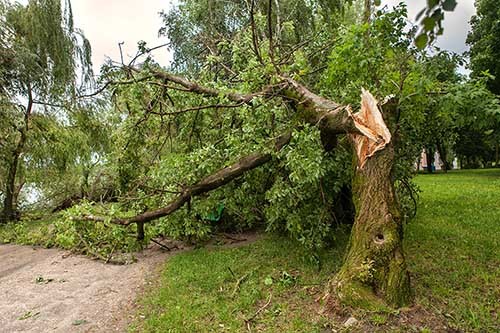How to Spot the Early Signs of Tree Failure to Minimize Danger on Your Property
Decaying trees on your property pose a danger to you, your home, and even your neighbors. If you have trees around your home, learning to recognize the potential signs of tree failure is your responsibility to your community.
When evaluating trees on your property for any signs of potential failure, it is important to understand the way a tree can fail, why it will fail, and the warning signs you should keep an eye out for. Read on to learn more about risk assessment and the visual signs to look out for when assessing the trees on your property for potential failures.
What is Tree Failure?
Tree failure is a structural deterioration or breakage of any part of a tree, including the roots, trunk, or canopy branches. A tree can experience catastrophic or complete failure or partial limb failure. In the event a tree limb fails, the remaining standing portion of the tree is not necessarily dead, but should be inspected by a certified arborist.
What are the Dangers of Tree Failure?
- Personal injury
- Property or home damage
- Road blocking
- Damage to power lines or other utilities
- Increased wildfire risks
Sometimes the signs of tree failure are obvious. Easy symptoms to spot include large cracks or fissures in limbs, areas of bark disappearing, or reduced leaf production. Signs of internal rot, wood-boring pest infestation or fungal infection are all severe symptoms of potential tree failure but can be harder to diagnose.
Signs of Tree Failure Starting at the Ground Floor
You want to start inspecting your trees for possible failure at the ground. Signs of possible failure at the ground level indicate that the entirety of the tree is at risk of failure. If you see signs of distress in a tree’s canopy such as loss of leaves, dead or brittle branches, it could actually be caused by something within the structure or roots.
If you are noticing any signs of distress in your trees, consult an experienced arborist at Vintage Tree Care for an assessment to avoid the possibility of catastrophic failure.
- Mushroom and Fungus: When mushrooms – also referred to as conks, bract, or shelf – grow on or immediately surrounding your trees, it is usually a sign that it is infected. While not all mushrooms are harmful to trees, many are, so the appearance of them should be a red flag.
- Lifting Soil or Roots: This is a sign of inadequate root anchoring and structural weakness at the foundation of the tree. It can indicate crown rot, which is a disease caused by a soil fungus. There is little to be done if your tree is suffering from crown rot. It is likely it will need to be removed before the entire tree fails.
- Sawdust or Bark Shed: Noticeable shedding of bark near the ground level or the sudden appearance of sawdust around your tree could indicate a pest infestation. Wood-boring pests such as the Bark Beetle, make their homes inside a tree, feeding off it, and slowly killing it. If pests inhabit one tree, all the other trees on your property are put at risk of infestation as well.
Signs of Tree Failure Throughout the Structure
If the ground, roots, and surrounding soil show no obvious signs of distress, you will want to examine the structure of your tree. Signs further up on the limbs of your trees could lead to partial failure, and cause major harm and damage if not addressed.
- Large Cavities: To an untrained eye, it could be difficult to tell if a tree on your property is structurally sound and cavity-free. Cavities in trees can be caused by a number of different things, such as an old pruning accident or previous limb failure. Even if your tree experiences new growth around an old wound, the interior structure could be compromised by decay. This leads to a common external sign of a cavity in a tree – swelling. If you notice random areas of swelling in trunks or branches, this could indicate the interior structure of the tree is dead due to decay.
- Nesting Cavities: Smaller nesting cavities that you find higher up in the limbs of trees are easy to spot because you will commonly see birds or other wildlife coming in and out of them. If an animal can nest in your tree, that means there is a cavity inside the limbs, and any cavity can indicate internal decay.
- Tree Limb Union: A tree with a large number of limbs splitting off from one common union point is a recipe from potential limb failure. This asymmetrical weight distribution could lead to a number of possible risks like cracking at the union point, or fissures in the limbs which would result in limb failure.
- Leaning Trees: If you notice a tree on your property leaning at an angle, look at the amount of top growth that could be weighing it down. Simple pruning could solve this issue. Make sure to inspect the surrounding soil for lifting, which would indicate the tree is leaning due to severe stress and is at risk of failing.
Contact a certified arborist to inspect any leaning trees on your property that may pose a danger to you or the surrounding area.
Signs of Tree Failure in the Canopy
Ignoring any warning signs in the canopy could result in damage or harm caused by falling branches. If left untreated, canopy issues could lead to larger issues with the limbs or even complete tree failure.
- Branch Health: If branches appear smaller, barren of foliage, or are extra brittle, this could be an indication of disease that could lead to limb or tree failure if left unattended.
- Leaf Health: If you have noticed certain areas of a tree are producing fewer leaves, or the tree has started producing fewer leaves altogether, this is a red flag.
Contact Vintage Tree Care for a Tree Risk Assessment and All Tree Maintenance
For over 14 years our team at Vintage Tree Care has been providing Sonoma County home and business owners with expert tree care. Contact us today for a property risk assessment or to request a tree service estimate.
Our skilled arborists are here to help ensure the health of your trees and the safety of your Sonoma County property for years to come.



